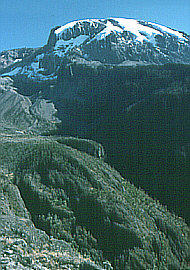
| Kilimanjaro |  |
1984 | The two pictures of the southern icefields were taken from near the Barranco Hut, the first in 1984, the second in 1998. The most evident changes have occurred on the Heim Glacier. In 1984 this is seen to have a "dog leg" in it; it reached down lower than any of the other glaciers in this, the central part of main southern icefields. In 1998 it is seen its upper reaches to have a much bigger gap separating it from its neighbouring glacier to the right. The bottom section, below the original dogleg, is totally missing and represents a loss of ice extending about 300m vertically. |  1998 |
The remnants of the ice cap can be seen as the spectacular ice cliffs of the Northern and Eastern Icefields, and the longest glaciers are found on the precipitous southern and south-western flanks. If the present rate of recession continues the majority of the glaciers on Kilimanjaro could vanish altogether in the next 50 years.